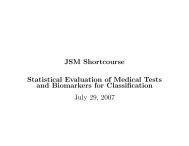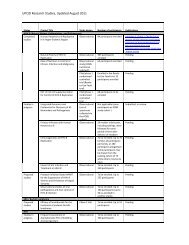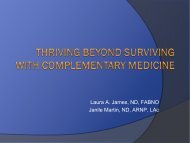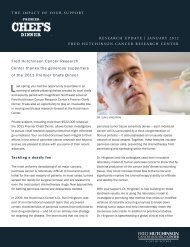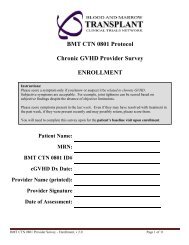Summer Undergraduate Research Program - Fred Hutchinson ...
Summer Undergraduate Research Program - Fred Hutchinson ...
Summer Undergraduate Research Program - Fred Hutchinson ...
Create successful ePaper yourself
Turn your PDF publications into a flip-book with our unique Google optimized e-Paper software.
Gut Microbiota Comparison in Women with High and Low<br />
Body Mass Index Using Quantitative PCR Analysis.<br />
B. Hammons1 , M.A. J. Hullar2 , F. Li2,3 , J.W. Lampe2,3 .<br />
1 New Mexico State University, 2<strong>Fred</strong> <strong>Hutchinson</strong> Cancer Res. Ctr., Seattle,<br />
WA, 3 Univ. of Washington, Seattle, WA.<br />
2009 Best Poster Presentation Award<br />
RESULTS:<br />
Linear regression showed a positive association between<br />
Bacteroidetes ratio and BMI (P=0.001). No association between<br />
BMI and Clostridial cluster XIVa or Archaea.<br />
ANOVA test showed a significance difference of Bacteroidetes<br />
ratio among three BMI groups (P=0.0003). Scheffe post hoc test<br />
showed significant differences between groups of BMI >30 to<br />
BMI 30 and 22‐30<br />
(P = 0.014).<br />
There were no significance differences in % of Archaea and<br />
Clostridial cluster XIVa between BMI groups. (Figure 2)<br />
AIM:<br />
To estimate the gut composition of selected microbial groups in a<br />
population of women with a broad range of BMI.<br />
INTRODUCTION<br />
Gut microbial community is populated by 10 Eubacteria phyla and 1<br />
Archaea. The majority of bacteria are Bacteroidetes and Firmicutes.<br />
METHODS:<br />
Study population Fecal samples were collected previously from<br />
120 premenopausal women aged 40‐45y. Women were identified<br />
from the Group Health Breast Cancer Screening <strong>Program</strong>.<br />
Exclusion criteria were women taking exogenous hormones or<br />
antibiotics 3 months prior to study participation [5].<br />
Dietary fiber is fermented by gut microbiota, producing short chain fatty<br />
acids (SCFA) propionate, acetate, butyrate, and lactate.<br />
SCFA are estimated to provide 10% of total dietary energy supply in<br />
humans.<br />
Stool Collection and DNA extraction. Fecal samples from<br />
participants were initially stored in RNAlater. For DNA extraction,<br />
samples were homogenized in RNAlater. DNA was extracted using<br />
the optimized method of Li et al [6].<br />
Increased hydrogen‐oxidizing methanogenesis promotes fermentation<br />
and produces more SCFA. Propionate, lactate and butyrate can be<br />
converted to acetate, which in combination with hydrogen, is used by<br />
Methanogens (Figure 1). Methanogens are the only Archaea found in<br />
human gut. It is hypothesized that an increase in Methanogen<br />
populations would increase the fermentation of dietary fiber.<br />
QPCR – Quantitative PCR (QPCR) with variable primers was used<br />
to quantify total microbial 16S rRNA gene copy numbers as well as<br />
Bacteroidetes, Clostridial cluster XIVa and Methanogens (Table 1).<br />
Total DNA preparations from gut microbiota were used as<br />
templates for PCR amplification in an ABI Prism 7900HT Sequence<br />
Detection System (Applied Biosystems, Foster City, CA) using SYBR<br />
green QPCR kit (Invitrogen, Carlsbad CA). Optimized QPCR<br />
conditions were used according to Zhang, et al [1]; Rekha et al [7];<br />
Matsuki, et al [8]; Ahmend et al [9].<br />
The presence of Methanogens in obese individuals is hypothesized to<br />
increase energy uptake of SCFA by consuming hydrogen, which increases<br />
fermentation efficiency of carbohydrates and proteins [1].<br />
164<br />
Studies of Firmicutes and Bacteroidetes ratio in obese populations have<br />
shown conflicting data. Ley et al showed that there were more Firmicutes<br />
and fewer Bacteroidetes in obese individuals than lean counterparts [2].<br />
In contrast, others have found no difference in Bacteroidetes group<br />
between obese and lean individuals [3, 4].<br />
Figure 2. Percentage of Bacteria and Archaea among BMI groups.<br />
SUMMARY:<br />
Ratio of Bacteroidetes to total Eubacteria (assessed by 16S<br />
rRNA gene copy number) was positively associated with BMI,<br />
whereas there was no association between those of Clostridial<br />
group XIVa and Archaea and BMI.<br />
Other studies showed an increase in Bacteroidetes with<br />
weight loss [2], no change in Bacteroides or Clostridial clusters<br />
XIVa [3], and positive association between Methanogens and<br />
Prevotellaceae and BMI [1].<br />
Ours is the largest study to date of a well‐defined, relatively<br />
homogeneous sample of women. The difference in the trends<br />
of the gut microbiota with obesity across studies could reflect<br />
the different human populations sampled.<br />
Further evaluation of these data is needed.<br />
Table 1. QPCR primers of selected microbial groups<br />
References:<br />
1. Zhang, H.S., et al., Human gut microbiota in obesity and after gastric bypass. Proc Natl Acad Sci USA, 2009. 106(7): 2365‐2370.<br />
2. Ley, R.E., et al., Microbial ecology: human gut microbes associated with obesity. Nature, 2006. 444(7122): 1022‐3.<br />
3. Duncan, S.H., et al., Reduced dietary intake of carbohydrates by obese subjects results in decreased concentrations of butyrate<br />
and butyrate‐producing bacteria in feces. Appl Environ Microbiol, 2007. 73(4): 1073‐8.<br />
4. Armougom, F. and D. Raoult, Use of pyrosequencing and DNA barcodes to monitor variations in Firmicutes and Bacteroidetes<br />
communities in the gut microbiota of obese humans. Bmc Genomics, 2008. 9.<br />
5. Atkinson, C., et al., Demographic, anthropometric, and lifestyle factors and dietary intakes in relation to daidzein‐metabolizing<br />
phenotypes among premenopausal women in the United States. Am J Clin Nutr, 2008. 87(3): 679‐87.<br />
6. Li, F., M.A. Hullar, and J.W. Lampe, Optimization of terminal restriction fragment polymorphism (TRFLP) analysis of human gut<br />
microbiota. J Microbiol Methods, 2007. 68(2): 303‐11.<br />
7. Rekha, R., et al., Designing and validation of genus‐specific primers for human gut flora study. J of Biotechnology, 2006.<br />
9(5):505‐11.<br />
8. Matsuki, T., et al., Development of 16S rRNA‐Gene‐Targeted Group‐Specific Primers for the Dectection and Identification of<br />
Predominant Bacteria in Human Feces. Appl Environ Microbiol, 2002. 68(11); 5445‐51.<br />
9. Ahmed, S., et al., Mucosal‐Associated Bacterial Diversity associated with Human Terminal Ileum and Colonic Biopsy Samples.<br />
Appl Environ Microbiol, 2007. 73(22); 7435‐42.<br />
Data analysis – Linear Regression was performed between BMI<br />
and transformed 16S rRNA gene copy number ratios of selected<br />
bacterial groups or Archaea to total Eubacteria. BMI was also<br />
categorized into tertile groups (30<br />
kg/m2 ). We used an ANOVA with post hoc testing (Scheffe test)<br />
on transformed Bacterial or Archaeal 16S rRNA gene copy<br />
number ratio to determine any significant difference between<br />
BMI groups.<br />
Figure 1. Anaerobic degradation of organic matter showing relationship<br />
between gut bacteria fermentation and hydrogen use by Archaea.<br />
We hypothesized that increased body mass index (BMI) would be<br />
positively associated with Firmicutes (Clostridial cluster XIVa) and<br />
Methanogens and inversely associated with Bacteroidetes.<br />
This work is supported in part by NCI grants: 5 U54 CA132381 (FHCRC), 5 U54 CA132383 (NMSU) and R01<br />
CA97366.




